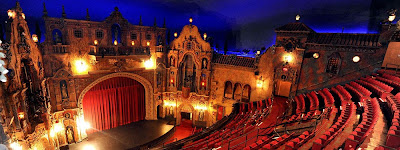 |
| Mark D. Ruffner © 2013 |
Several times a year, I cross Tampa Bay to go to the Tampa Theater, usually to see a good documentary. It's always a special treat.
 |
| Mark D. Ruffner © 2013 |
Tampa Theater was designed by architect John Eberson in 1926. It was hugely popular when it opened because it was Tampa's first public building to be air conditioned. The building's facade hints at the ornate design within.
 |
| Mark D. Ruffner © 2013 |
This ceiling, which strikes me as Venetian in design, is above the ticket booth and extends into the lobby. Elaborate tile patterns are throughout the theater.
 |
| Mark D. Ruffner © 2013 |
 |
| mitampabay.com |
 |
| click to enlarge | ignitetampa.org |
I always gravitate to the balcony, all the better to take in the theater's decor, an ornate architectural facade. The theater is usually darkened, but I was able to shoot the detail below without using a flash.
 |
| Mark D. Ruffner © 2013 |
 |
| Mark D. Ruffner © 2013 |
There's a concert of period music before every showing, when an organ rises from beneath the stage. Just before the movie begins, the organist acknowledges the audience with a wave of his hand, and then the organ descends back down to the basement.
 |
| Mark D. Ruffner © 2013 |
There are several fountains like this one throughout Tampa Theater, and wonderful details at every turn, like the alcove and urn, below.
 |
| Mark D. Ruffner © 2013 |
 |
| Mark D. Ruffner © 2013 |
Amazingly, almost nothing has changed since 1926 — just look at this great sign in front of the men's room. Below is one corner of the men's room, glistening with gold tile. I wouldn't be at all surprised if an attendant sat in that chair at one time.
 |
| Mark D. Ruffner © 2013 |
By 1973, Tampa Theater had fallen on hard times and was in jeopardy of being torn down like so many other great theaters around the country. But the citizens of Tampa rallied behind it, the city assumed its leases and today it's run by a not-for-profit foundation. The Hillsborough County Arts Council manages the films shown at the theater, and holds over 600 events there each year. In 1978, Tampa Theater was named to the National Register of Historic Places.
 |
| Mark D. Ruffner © 2013 |
One last look back as we exit the theater lobby.
.
























































